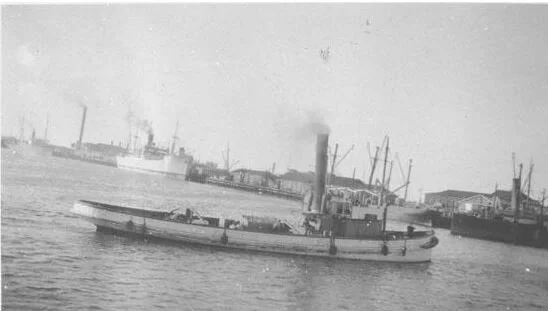Charles Coalstad
(1866 -1934)
Captain Charles Severin Coalstad was drawn to the sea at a very young age, living a life worthy of a series of adventure books. It was said of him that "No finer sailorman ever used the port of Fremantle." (reference)
Born 1866 in the harbour district of Porsgrunn, Norway, Charles went to sea whenever he could as a lad (reference). At 15, he was shipwrecked off the coast of Mexico, so he made his way to America where he entered the US Revenue Service (reference). In 1882 he left the Service to sail around the world as a Second Mate on Charles Miller’s pleasure yacht for the next 3 years (reference).
In 1900 Charles was the captain of the S.S. Cambria when it sank on a trip from Fremantle to Bunbury. A Western Australian Museum publication, The Cambria Rediscovered describes the sinking as follows:
“The Cambria left Fremantle at 4 pm on 4 March 1900 with eight crew and one passenger bound for southwest ports with a general cargo and machinery. After departing Fremantle the ship ran into a southwest gale with heavy seas, so Captain Coalstad headed for the South Passage of Garden Island to seek shelter in Mangles Bay, Rockingham. However, on reaching the South Channel at 8.30 pm, a heavy swell lifted the ship to leeward and it struck a reef on the southwest of Garden Island. The ship was put full astern, but the propeller broke and it started taking on water. The pumps could not cope and at 10 pm it filled with water and sank with the masts and funnel showing. The crew spent the night clinging to the rigging. The next day they launched the lifeboat and all of the crew, passenger Mr Reid and ship’s cat made it to a sandy beach on Garden Island. They found some old sails and rigged the lifeboat and sailed back to Fremantle arriving at 3 pm.”
Jeremy Green, Western Australian Museum, 2010
After surviving the wreck, Charles was charged with “want of judgment in attempting to enter the South Channel at the south end of Garden Island, on Sunday, March 4, thereby causing your vessel to become a total wreck” and “guilty of carelessness when attempting to enter the said passage in not taking soundings or having a special look-out kept, considering the dangerous nature of the passage as described in the Admiralty sailing directions” (reference). In court, he was found guilty and his master’s certificate was suspended for 6 months, but could still sail with his mate’s certificate (reference).
In 1903 Charles married Mary Ada Smith in Perth (reference). The couple lost their firstborn son in 1904 (reference) and twin boys in 1910 (reference). They moved to Molloy Street, Bunbury in 1905 and had three children who survived infanthood; Nora, born 1905 (reference), who became a well-known pianist (reference and see more information on her under Notable People), Stanton, born 1907 (reference) and Heather, born 1913 (reference).
Charles sailed the tug Vigilant from Adelaide to Bunbury in 1903 for Millers’ Karri and Jarrah Timber Co. (reference). He remained the Master of the tug until its final trip in 1913 from WA to Adelaide. As well as performing harbour work, the tug was used for many social outings to Busselton and moonlight trips around the harbour (reference).
In October 1915 Captain Charles Coalstad sailed from Fremantle in the S. S. Moorina, formerly the German ship Thuringen, which had been captured in Fremantle and resold to India. As chief officer of the Royal Indian (Prize Section) Marine Transport, Charles’ job was to transport Indian troops in the Mediterranean. Sea travel was dangerous with WWI raging, which Charles experienced firsthand when the Moorina and another British ship, the Tara, were sunk by German submarines. Luckily, most of the crew and passengers survived and made it to shore, only to be taken prisoner by the Senussi Tribe and held captive in the Sahara Desert. Conditions were harsh with scarce rations and some men died from ill-health. Those that survived the ordeal were rescued in March 1917 by a squad of armoured cars led by the Duke of Westminster. (reference)
After his rescue, Charles returned home to Bunbury where he was greeted by a welcome home social from the local community (reference). In 1918 the Coalsteads moved to 22 Hamilton Street, East Fremantle, where Charles joined the Commonwealth lighthouse service, commanding first the tender Governor Musgrave and then the Kyogle (reference). Despite retiring in 1931, he was asked by the Cossack Lightering Company in 1934 to select a barge suitable for use at Cossack, Pilbara, Western Australia. A 70-year-old schooner from Adelaide, the Uribes, was chosen, which he sailed back to Onslow (reference). After a life spent on the sea, Charles died there of a heart attack aged 68 (reference).
This article has been researched and written by Gaye Englund for www.streetsofbunbury.com and www.streetsofeastfreo
Captain Colstead 1934 Western Mail, Thu 15 Nov 1934





